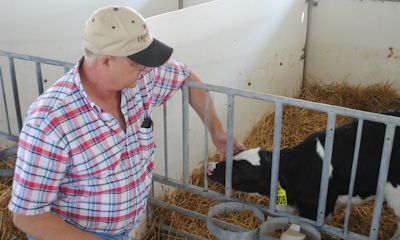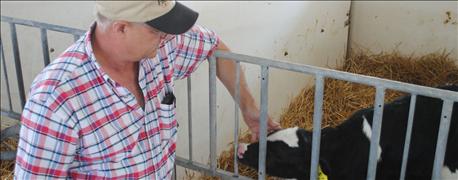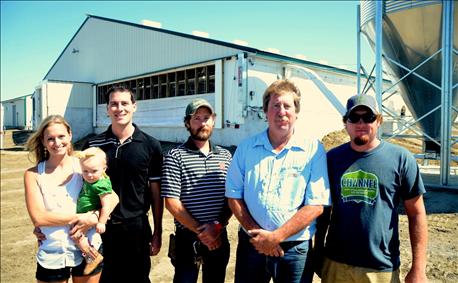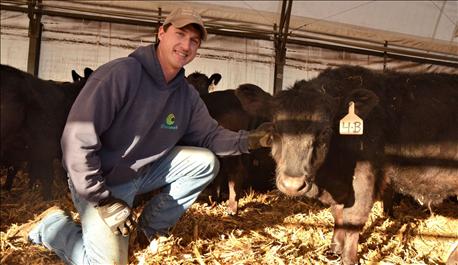
Expanding the livestock feeding sector has been a big topic of discussion over the last few years in Nebraska. A recent Livestock Expansion White Paper by University of Nebraska-Lincoln's Department of Agricultural Economics assessed the benefit to Nebraska if the state were to realize a 25% increase in market hogs, an increase of 60,000 dairy cows, a 10% increase in fed cattle, and a tripling in egg production. The result: 19,000 new jobs, $800 million in labor income, an increase in value-added activity of $1.4 billion.

LOOKING TO THE FUTURE: NSDA President Bill Thiele discussed the potential for growth in Nebraska’s dairy industry at last year’s convention. Here, Thiele inspects a baby calf at Thiele Dairy near Clearwater.
But what are some of the ways livestock producers are expanding in the state? We've compiled some of our top stories over the last year to give you a look at how livestock producers are expanding their operations in Nebraska, as well as a look at some of the hurdles to overcome in expansion.
Find and keep good employees - Finding and keeping good help around the farm has always been a challenge. Several Nebraska feedlots have found a recipe for locating, hiring and retaining many of their employees over the long haul.
Dairy leaders plan for boom - Nebraska's dairy herd grew by 4,000 to 5,000 head in 2014, due to the addition of a new dairy in Dixon County and expansion of existing dairies – well on its way toward the Nebraska State Dairy Association's goal of increasing the state’s dairy herd by 30,000 head in five years.
Husker Home Place: Livestock farms depend on stewardship of land and relationships - As we talk about the advantages Nebraska offers for livestock production, with ample water, grain, land and resources, we must also talk about the importance of expanding our livestock in the right way.

FAMILY FARM: John Tyson and family at the open house of the new hog barn. Right to left are John's son Cody, who is also coming back to the farm, John, Joel, who will manage the new hog barn, John's son Zach, his daughter Thea, and wife, Trisha.
State’s dairy industry readies for growth - At the 2015 Grow Nebraska Dairy Summit in June, producers and stakeholders discussed the progress and hurdles to growing Nebraska's dairy sector. The opportunities lie in the availability of land, water, feed, and ethanol coproducts in Nebraska, but there are challenges to overcome, most notably in bringing new processors into the state.
Large dairy brings big benefits for local farmers - A look at Butler County Dairy and Double Dutch Dairy, both near Rising City, the benefits they bring to local farmers by providing a source of manure for fertilizer and a place to market silage. Todd Tuls, owner and manager of the two dairy farms, also discusses the advantages Nebraska brings as an ideal location for expanding a dairy operation.

A DIFFERENT KIND OF MANAGEMENT: Raising pairs in a Hoop Beef System takes a different kind of management compared to raising pairs on pasture. It requires tending to cows and calves every day, so it doesn't take long for cows and calves to get used to being around people. "It's not like turning 200 cows out on to pasture for five months and seeing them once a week," says Daryl Crook. "You're there at the bunk every single day."
Bringing home the bacon and the next generation - John Tyson and his family were able to bring home the next generation of producers by building a new hog feeding barn and contracting with the Maschhoffs, LLC. Tyson notes while making a place for two of his sons to come back into the operation, it also provides roughly $40,000 worth of free fertilizer every year.
Butler County producer invests in a new kind of cow-calf system - A look at how Butler County producer, Daryl Crook raises cow-calf pairs under roof year-round, using a building from Hoop Beef System, LLC, and using available resources like corn, corn stover, and co-products.
3 communication skills to help prevent costly employee turnover - Finding and keeping good employees is always a challenge on the farm. Dairies in particular rely on a skilled workforce. Retired North Dakota State University Extension dairy specialist, J.W. Schroeder discusses three avenues of communication for supervisors to share their vision.
About the Author(s)
You May Also Like






